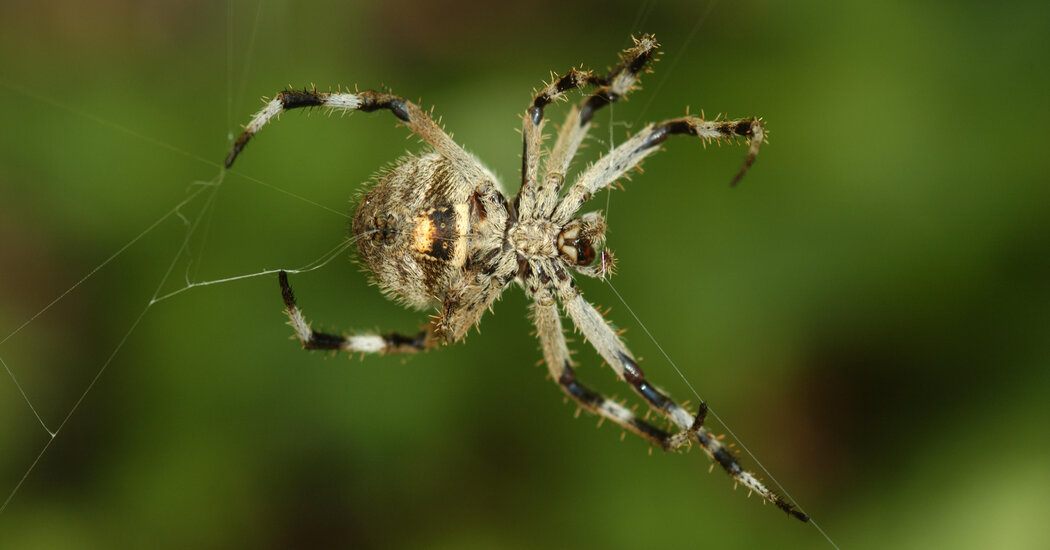Pound for pound, spider silk is stronger than steel and tougher than Kevlar. But it doesn’t start out that way.
The silk starts out in a liquid form called dope (literally, dope). But in fractions of a second, this goopy, liquid slurry of proteins is transformed. And it doesn’t just turn into a solid. On their way out of a spider’s bottom, the protein building blocks in silk, called spidroins, fold themselves and interlace, creating a highly organized structure without guidance from any outside force.
This remarkable process of self-assembly is about as strange as a garden hose spitting out a stream of perfect snowflakes. Scientists have spent years trying to mimic it in the hopes that it will someday revolutionize the construction of ultra-strong, sustainable materials.
“You can really generate materials with unique properties by exploiting this self-assembly process,” said Ali Malay, a structural biologist and biochemist at the Riken Center for Sustainable Resource Science in Japan.
Dr. Malay doesn’t yet have the entire process figured out. Neither does anyone else. But in a paper published Wednesday in Science Advances, he and his colleagues lay out a new way to tackle the spider silk puzzle, mimicking its orderly exit from the spinneret with chemical tools in the lab.
A crucial part of spinning, the researchers found, requires the spidroins to separate themselves from the watery buffer that swaddles them inside silk glands — a step that hyper-concentrates the proteins. An influx of acid then prompts the proteins to securely interlock.
The paper uses a simplified laboratory model in place of real spiders. But the research is remarkable for providing a glimpse into the sausage-making behind silk spinning, “from liquid dope to fiber,” said Angela Alicea-Serrano, a spider silk researcher at the University of Akron who wasn’t involved in the study. “We’ve seen a lot of the beginning of this process and the end, but not the in-between.”
The metamorphosis spider silk must undergo as it exits an arachnid cannot be overstated, said Anna Rising, a spider silk expert at the Karolinska Institute in Sweden who was not involved in the study. While still in the gland, spidroins have to stay suspended in a liquid form at “really extreme concentrations,” Dr. Rising said. “It’s viscous, almost like a toothpaste.”
If the silk hardens too soon, it could clog the spider’s glands with a nightmarishly webby form of constipation. Too late, and the arachnid might spew only shapeless liquid. That makes both timing and efficiency central to the silk-spinning process.
Luckily for spiders, millenniums of evolution have made spidroins versatile. The proteins, Dr. Rising explained, are structured like barbells: a long, disorderly string capped on each end by a bolt-like blob. In the silk glands, these barbells are thought to naturally pair up at one end, creating V-shaped duos that slosh around in the dope.
To form the more stable architecture required of solid silk, the spidroins need to link up in chains, using the other ends of the barbells. That seems to happen under the influence of a couple of chemical cues, said Jessica Garb, a spider silk researcher at the University of Massachusetts, Lowell who was not involved in the study. As the spidroin slurry is extruded through a labyrinth of increasingly narrow ducts, the spider cells pump acid into the mixture, making the free ends of the barbells stick together. The journey through these tapering tubes also tugs and squeezes the silk into its final form.
Dr. Malay and his colleagues found that this sculpting and self-assembly could not happen if the liquidy spidroins weren’t dehydrated as they moved through the spider’s anatomy.
Further experiments showed salts made the proteins rapidly distance themselves from the liquid surrounding them, like oil and vinegar in a salad dressing. This allows the spidroins to more easily interact, said Cheryl Hayashi, a spider silk researcher at the American Museum of Natural History who wasn’t involved in the study. Freshly thickened, the stew of spidroins then shapes itself into an increasingly stringy structure.
The silk extrusion pipeline might sound a bit cumbersome. From an engineer’s perspective, though, it’s extraordinarily elegant, said Keiji Numata, a Riken scientist who led the study. Scientists can build superstrong polymers in the lab through brute force, coercing materials to come together in ways they otherwise wouldn’t. But given the right ingredients, under the right conditions, the recipe that is spider silk essentially cooks itself.
Researchers still don’t know enough about this process to fully recreate it. There are also many ways to spin spider silk, which varies between species, and even within the same spider, Dr. Garb said. Although silks might be best known for their roles in web-building, they can also be used to lure mates, protect eggs or even help wayfaring spiders hitch a ride on a passing breeze.
This study focused on the proteins found in dragline silk, which serves as a sort of bungee cord for spiders dangling from their webs or ceilings. “But there’s still a lot more that nature has figured out that we don’t know about,” Dr. Hayashi said.
Source: Read Full Article
